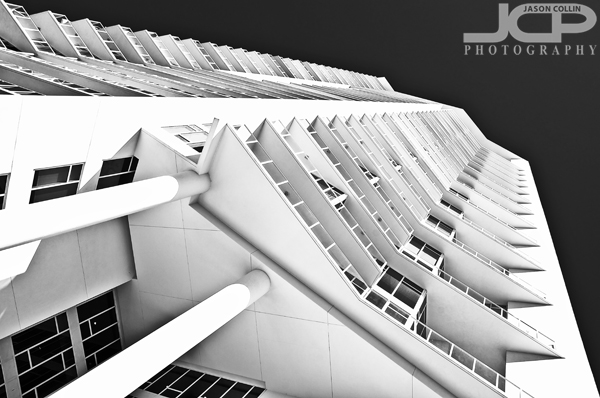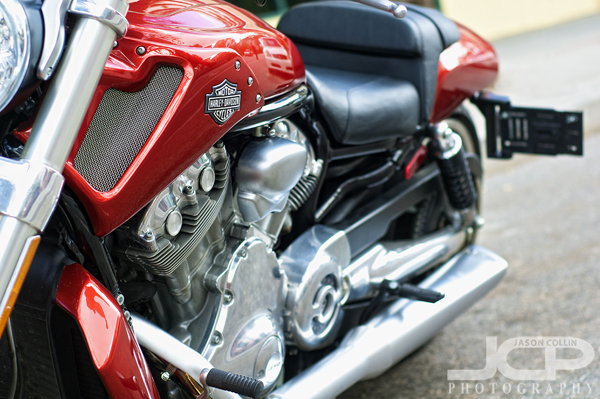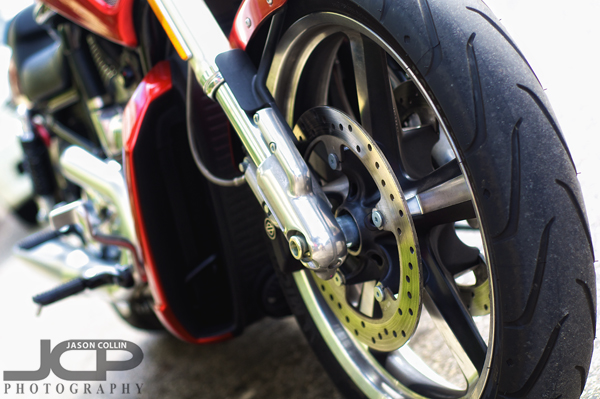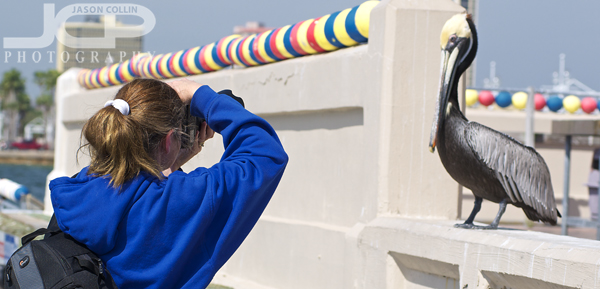 When looking to make a photograph remember to also look up!Pushing the shutter on your camera when looking at a subject at eye level with nothing else special done is very likely to result in an uninteresting photograph. Shooting like these I often refer to as just snapshot photography. I tell my photography students that to make a photograph one often has to show the viewer something she/he cannot also see simply by standing there too. One of the easiests ways to compose a shot that breaks from this constraint is to simply look, up! A sharp eyed viewer will also notice one of my other favorite composition techniques in the above shot of Signature Tower in downtown St. Petersburg--ending lines flush in corners.
When looking to make a photograph remember to also look up!Pushing the shutter on your camera when looking at a subject at eye level with nothing else special done is very likely to result in an uninteresting photograph. Shooting like these I often refer to as just snapshot photography. I tell my photography students that to make a photograph one often has to show the viewer something she/he cannot also see simply by standing there too. One of the easiests ways to compose a shot that breaks from this constraint is to simply look, up! A sharp eyed viewer will also notice one of my other favorite composition techniques in the above shot of Signature Tower in downtown St. Petersburg--ending lines flush in corners.
composition
Photography Tip - get close, then get closer for higher impact images
 Getting in very close on this photograph of Kiki showing her viewpoint and thoughts.Getting in close to your subject is one way to immediately add more impact to the photograph. Once you think you have gotten in as close as you should, try going in even closer. This is especially true for portraits, as seen above in the portrait of Kiki seemingly in deep thought. The framing only reveals her right eye and some of her head leaving all else a mystery to the viewer.
Getting in very close on this photograph of Kiki showing her viewpoint and thoughts.Getting in close to your subject is one way to immediately add more impact to the photograph. Once you think you have gotten in as close as you should, try going in even closer. This is especially true for portraits, as seen above in the portrait of Kiki seemingly in deep thought. The framing only reveals her right eye and some of her head leaving all else a mystery to the viewer.
It helps to use a macro lens to make this kind of shot. Another good way is to use a long focal length (200mm+).
 Get close, and then closer even for group portraits to capture more emotion.The get close, and then get closer composition style also works for group portraits, not just single subject portraits. In the above example showing the groom and groomsmen head to toe is a fine shot, but the viewer feels distant from the subject. Zooming in and composing a much tighter shot reveals each person's individual character more and makes for a much more personal experience for the viewer.
Get close, and then closer even for group portraits to capture more emotion.The get close, and then get closer composition style also works for group portraits, not just single subject portraits. In the above example showing the groom and groomsmen head to toe is a fine shot, but the viewer feels distant from the subject. Zooming in and composing a much tighter shot reveals each person's individual character more and makes for a much more personal experience for the viewer.
Try getting much closer than you normally do in composing your shots and let me know in the comments below what the results were.
Harley-Davidson 50mm Motorcycle Series St. Petersburg Florida Photography
 Harley-Davidson in downtown St. Petersburg Florida - Nikon D300 Nikkor 50mm @ f/2.8 ISO 200 1/250thI like to photograph motorcycles with a 50mm lens. I saw this Harley-Davidson parked in downtown St. Petersburg Florida. Using a 50mm f/1.8 lens lets me select only a part of the motorcycle to show in focus by using a large aperture creating a shallow DoF. I like this style for motorcycles where the bike is shown in ever increasing blur from front to back.
Harley-Davidson in downtown St. Petersburg Florida - Nikon D300 Nikkor 50mm @ f/2.8 ISO 200 1/250thI like to photograph motorcycles with a 50mm lens. I saw this Harley-Davidson parked in downtown St. Petersburg Florida. Using a 50mm f/1.8 lens lets me select only a part of the motorcycle to show in focus by using a large aperture creating a shallow DoF. I like this style for motorcycles where the bike is shown in ever increasing blur from front to back.
 Shooting motorcycles with a 50mm lens - Harley-Davidson - Nikon D300 Nikkor 50mm @ f/2.8 ISO 200 1/250thUsing a 50mm lens up close also means the whole motorcycle cannot be fit into the frame, which I think is a plus. It is much easier to get creative with composition with focal length restrictions.
Shooting motorcycles with a 50mm lens - Harley-Davidson - Nikon D300 Nikkor 50mm @ f/2.8 ISO 200 1/250thUsing a 50mm lens up close also means the whole motorcycle cannot be fit into the frame, which I think is a plus. It is much easier to get creative with composition with focal length restrictions.
Nikon D7000 1-on-1 DSLR Photography Lesson at The Pier in St. Petersburg Florida with Patricia
 Patricia aims her Nikon D7000 at a pelican out on The Pier during our second DSLR photography lessonFor our second of four 1-on-1 DSLR Photography Lessons I met Patricia on a pleasant Florida winter Saturday morning and headed out to The Pier to photograph pelicans and whatever other surprises we may find there. For this lesson Patricia used her Nikkor 70-300mm VR lens exclusively on her Nikon D7000. I recommend having all your gear setup and ready to shoot as you approach a location, so even before we got to The Pier I went over the recommended settings to use with a 70-300mm lens for birds & other small, distant subject matter.
Patricia aims her Nikon D7000 at a pelican out on The Pier during our second DSLR photography lessonFor our second of four 1-on-1 DSLR Photography Lessons I met Patricia on a pleasant Florida winter Saturday morning and headed out to The Pier to photograph pelicans and whatever other surprises we may find there. For this lesson Patricia used her Nikkor 70-300mm VR lens exclusively on her Nikon D7000. I recommend having all your gear setup and ready to shoot as you approach a location, so even before we got to The Pier I went over the recommended settings to use with a 70-300mm lens for birds & other small, distant subject matter.
During this second lesson we also focused more on composition, in particular not necessarily always framing things at right angles. Sometimes, a tilted axis composition style can added much needed pizazz to an otherwise common shot.
Use Negative Space when composing photography tip
 Composing with negative space - Nikon D300 Tamron 17-50mm @ f/11 ISO 200 1/400th
Composing with negative space - Nikon D300 Tamron 17-50mm @ f/11 ISO 200 1/400th
I often tell my DSLR photography students to "fill the frame" when composing shots. I also recently wrote about how not including the entire motorcycle makes for an image with more impact. That said, another composition technique follows just the opposite of those and calls for using negative space in the frame to be part of the photograph.
In the above image instead of filling the frame with the palm tree, or using a rule of thirds type of composition, the palm tree is composed as to look small and isolated allowing the negative space itself to be the main subject of the photograph. Filling the frame with negative space gives the impression of great expansion, or rather, no end once the eye reaches the edge of the frame. The viewer's eye continues on past the edges filled in by their own imagination of what goes beyond.
Post a link to your example of negative space composition in the comments below.
Architecture Photography Tip put building edge parallel to edge of the frame

This photography tip is about how to frame architecture shots with regards to the sides of the frame. When photographing a skyscraper like the one above, I like to get the opposite edge (in this case the left) of where the building starts from to end with a part of the building parallel to that edge.
In the shot on the right, the top of the building is at an angle to the left of the frame. To me this looks awkward and makes the viewer's eye uncomfortable when following the lines of the skyscraper. In the shot on the left, I composed so that the top of the building ended up parallel to the left (opposite edge) of the frame. The viewer's eye starts from right to left and continues up through the top of the frame.
What do you think about this small, but important composition detail?
Photography tip - compose with subject looking or going into the frame

great blue heron in profile looking into the frameOne easy to remember photography tip that will improve your shooting is to have the subject "looking" or "moving" into the frame. This means the subject should be at one edge of the frame appearing to look into or go into the empty space in the shot, rather than staring at the edge of the frame. A subject that looks into the frame or motion that leads into the frame gives the viewer's eyes some place to go.
FOR SUBJECTS IN PROFILE
 Kiki in profile looking into the empty frame makes my eyes follow hers.In the above photographs of a great blue heron and of beloved puppy Kiki, both subjects are shown in profile and both are looking into the empty frame. If I had composed the shots with the empty space to the right, the images would look awkward and unbalanced. When photography a subject in profile, be sure to include enough space for that subject, and the viewer, to look into.
Kiki in profile looking into the empty frame makes my eyes follow hers.In the above photographs of a great blue heron and of beloved puppy Kiki, both subjects are shown in profile and both are looking into the empty frame. If I had composed the shots with the empty space to the right, the images would look awkward and unbalanced. When photography a subject in profile, be sure to include enough space for that subject, and the viewer, to look into.
FOR SUBJECTS IN MOTION
 The airplane has enough space to "fly" into creating movement for the viewer.Likewise for subjects in motion, they should also have plenty of space to "move" into in the frame. This allows the viewer to look and see where the airplane is flying. The Jeep below suggests a continued movement and leading action. Having empty space to either the rear of the plane or Jeep would not only look awkward but show that we were too slow on the shutter to catch the action.
The airplane has enough space to "fly" into creating movement for the viewer.Likewise for subjects in motion, they should also have plenty of space to "move" into in the frame. This allows the viewer to look and see where the airplane is flying. The Jeep below suggests a continued movement and leading action. Having empty space to either the rear of the plane or Jeep would not only look awkward but show that we were too slow on the shutter to catch the action.
 This Jeep continues on because of the composition.
This Jeep continues on because of the composition.
FOR SUBJECTS LOOKING INDIRECTLY
 What is the flamenco dancer looking at? The composition gives enough space for the question to arise.When a subject is looking indirectly in the frame, space should still be given in the composition in the general direction the subject is looking. The flamenco dancer above is facing the lens, but looking to her right. Composing for more space on the left of the frame makes the viewer also look left. The wedding couple below are really looking indirectly in the frame, but overall both their poses and the directions of their eyes favor viewing from top right toward bottom left.
What is the flamenco dancer looking at? The composition gives enough space for the question to arise.When a subject is looking indirectly in the frame, space should still be given in the composition in the general direction the subject is looking. The flamenco dancer above is facing the lens, but looking to her right. Composing for more space on the left of the frame makes the viewer also look left. The wedding couple below are really looking indirectly in the frame, but overall both their poses and the directions of their eyes favor viewing from top right toward bottom left.
 Pose & composition direct the viewer to look from right to left.Keep the "look into the frame" composition tip in mind to produce photographs that give the subject and the viewer space to look into and avoid subjects staring into the edges of the frame.
Pose & composition direct the viewer to look from right to left.Keep the "look into the frame" composition tip in mind to produce photographs that give the subject and the viewer space to look into and avoid subjects staring into the edges of the frame.

